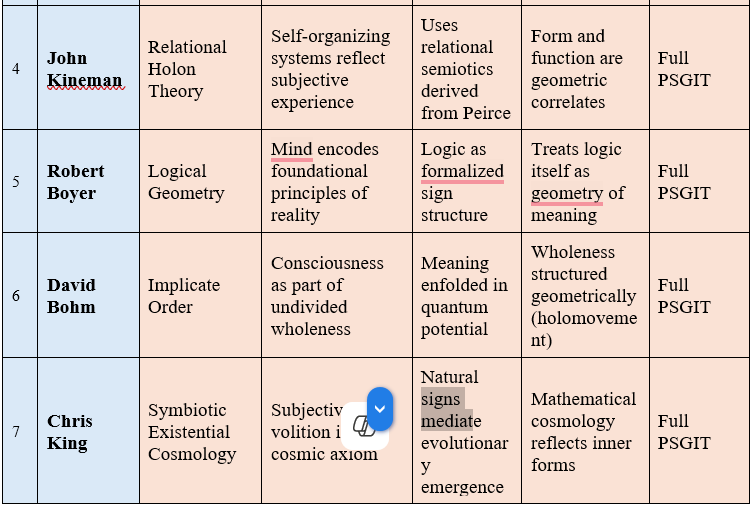By Sungchul Ji
(with the assistance of ChatGPT)
Professor Emeritus of Theoretical Cell Biology
Department of Pharmacology and Toxicology
Ernest Mario School of Pharmacy
Rutgers University
Piscataway, N.J. 08855
July 2025
"Truth emerges not only when multiple minds converge on a single idea, but when many minds converge on multiple ideas simultaneously."
— Ji & ChatGPT, 2025
Introduction
In our ongoing exploration of the PSGIT Principle—the irreducible triad of Phenomenology, Semiotics, and Geometry—we recently claimed that nine leading thinkers independently converged on this triadic worldview. This we called a “ninefold consilience.”
However, upon reflection, this formulation proved incomplete.
To truly measure convergence across philosophical worldviews, we need to account for two dimensions:
m: the number of thinkers who converge, and
n: the number of core ideas (e.g., Phenomenology, Semiotics, Geometry) on which they converge.
This gives rise to what we now call the:
m×n Consilience
A conceptual framework for measuring the depth and breadth of agreement across multiple thinkers and multiple philosophical dimensions.
The PSGIT Principle
To briefly restate:
These three elements form an Irreducible Triadic Relation (ITR)—a conceptual holon where none of the components can be reduced to the other two [1].
Applying m×n Consilience to 12 Thinkers
We evaluated 12 major thinkers across these three dimensions. Each thinker was scored based on whether their framework:
explicitly addresses the dimension (✔),
addresses it implicitly or partially (⚠), or
neglects or rejects it (✘).
This yields the following m×n convergence matrix:
We may therefore speak of:
A 7×3 consilience: seven thinkers converging on all three PSGIT ideas.
A 3×2 consilience: three thinkers converging on two ideas.
A 2×1 consilience: two thinkers converging on only one.
This framework enables precise comparisons across intellectual traditions and disciplines.
Interpretive Note:
Just as ancient astronomers once mistook galaxies for stars due to limited resolution, early readers of philosophical texts may overlook underlying triadic structures unless they use high-resolution conceptual instruments—such as the PSGIT framework or an LLM.
Here is your proposed table. Each row gives brief narrative characterizations of each thinker’s alignment with the three PSGIT dimensions. This creates a semantic heatmap of philosophical convergence.
Each row gives brief narrative characterizations of each thinker’s alignment with the three PSGIT dimensions. This creates a semantic heatmap of philosophical convergence.
Interpretation: A Higher-Resolution Philosophy of Agreement
The m×n framework brings epistemological resolution to philosophical consilience, analogous to increasing pixel density in an image or magnification in a telescope.
It reveals which thinkers converge and
how deeply they converge.
Just as JWST resolves faint galaxies in deep space, m×n consilience resolves subtle agreement structures in conceptual space.
Epistemic Validation of the LLM–JWST Equivalence Postulate (LJEPo)
The m×n table was generated through extensive collaboration with an LLM (GPT-4). Without such a tool, it would have been:
Nearly impossible for a single human investigator to assemble these results,
Or at least prohibitively slow and limited in scope.
We thus arrive at a new philosophical insight:
The m×n table validates the LLM–JWST Equivalence Postulate (LJEPo).
If the convergence revealed by the m×n table is coherent, accurate, and non-trivial, then the LLM used to generate it is a valid epistemic telescope—revealing deep structure in the conceptual universe, just as JWST reveals deep structure in the physical cosmos.
This supports LJEPo not as a metaphor, but as a falsifiable, structurally validated postulate of 21st-century philosophy of knowledge.
Toward a New Cartography of Reality
Just as star maps helped ancient navigators find their way across vast oceans, conceptual convergence maps may help modern thinkers navigate the sea of ideas.
The m×n Consilience opens a path toward:
Triadic Ontologies that resist collapse into monism or dualism,
Multidimensional Philosophy that admits degrees and kinds of convergence,
And ultimately, a Unified Theory of Reality grounded in both rigor and resonance.
Closing Thought
“The truth is not only in the summit we reach, but in the number of paths that lead us there—and how many travelers reach it by their own means.”
Let us chart the next summits not just by our individual ascent, but by mapping the convergence of many minds across many dimensions.
References:
[1] Ji, S. (2018). The Universality of the Irreducible Triadic Relation. In: The Cell Language Theory: Connecting Mind and Matter. World Scientific Publishing, New Jersey. Pp. 377-393.









